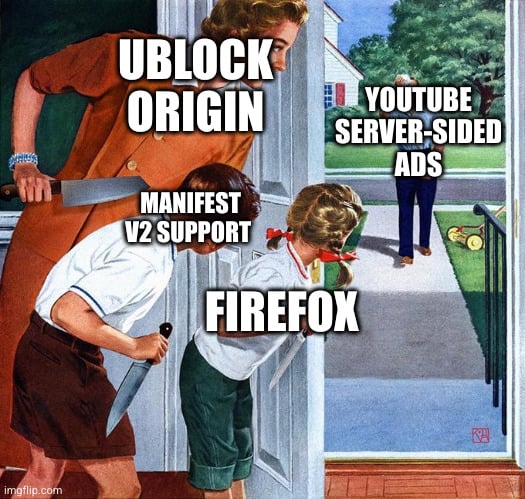I am not for ads but what is so difficult about adding them to the video stream. This should make adblockers useless since they can't differentiate between the video and the ad. I could just imagine it would be difficult to track the view time of the user and this could make the view useless since they can't prove it to the ad customer. I have no in depth knowledge about hls but as I know it's an index file with urls to small fragments of the streamed file. The index file could be regenerated with inserted ad parts and randomized times to make blocking specific video segments useless.
memes
Community rules
1. Be civil
No trolling, bigotry or other insulting / annoying behaviour
2. No politics
This is non-politics community. For political memes please go to [email protected]
3. No recent reposts
Check for reposts when posting a meme, you can only repost after 1 month
4. No bots
No bots without the express approval of the mods or the admins
5. No Spam/Ads
No advertisements or spam. This is an instance rule and the only way to live.
A collection of some classic Lemmy memes for your enjoyment
Sister communities
- [email protected] : Star Trek memes, chat and shitposts
- [email protected] : Lemmy Shitposts, anything and everything goes.
- [email protected] : Linux themed memes
- [email protected] : for those who love comic stories.
I worked at a video ad server that offered a stream stitched solution going back to 2013. It comes down to development work/cost that the companies need to take on. Ultimately they would benefit from the cost required, but they wanted to be cheap and do a client side solution instead.
Ah yes that makes a lot of sense. Googles war on adblockers seems really expensive but we don't know the numbers maybe it's still cheaper.
The HLS integration we offered definitely had a premium attached to it as well as an additional cost to the CDN that required the integration to live on. So it's not cheap.
It is weird that Google, with it's infinite pockets, hasn't pushed a stream stitched solution all these years until recently.
YouTube serves probably dozens of formats/bitrates, and has spent years tweaking how it ingests, transcodes, and serves videos. Adding in-stream ads might have been a bigger engineering task in that environment. Depending on the percentage of users/viewers avoiding ads, it might not have been worth the return.
It already happens, videos contain sponsored segments added by the creator.
But even those have a solution in the form of Sponsorblock, which crowdfunds the location in the video containing sponsored segments in order to skip them.
Google should face the fact that they won't ever be able to win.
Sponsorblock works with static timestamps provided by users. This would not work if the ads are inserted at randomized times.
Cause you need to insert it every time for every viewer. People get different ads and those ads obviously change over time. So embedding one ad into the video permanently makes no sense. I'm pretty sure YouTube does it the way they do cause the alternative is not feasible.
You can still do dynamic ad serving in a stream stitched integration. It's just that the content and the ads are being served by the same CDN, hence why you can't block the ads without also blocking the content. In the manifest file there are m3u8 chucks, the file is essentially broken up into 5/10 second chunks, and when the video segment chunk is coming to an ad break, it stitches in dynamically an ad m3u8 chunk that the ad server dynamically selects based on the ads they currently have trafficked in their system.
Grayjay ftw
It works really well, I want to support them and donate but I'm afraid YouTube will find a way to block them like they did to others...
There is a whole topic in wasm called server side rendered DOM.
I hardly think there is a chance to block adds when they achieve it to render all the content on their side.
But unless the page ends up as just a single canvas/image you'll still get all the HTML tags which can be stripped before your browser renders them?
Ads are not always the same, not for everyone. Ads are localized in time, space and per person sometimes.
An advanced adblock would just need to download the video from two sources match the videos and eliminate the differences as those differences will surely be ads.
